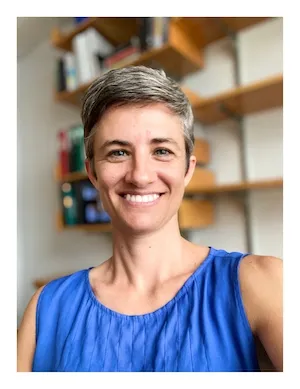Princeton Molecular Biology Course Uses CyVerse to Teach Lab Online
The class normally includes a three-hour science lab for nearly 200 students. When coursework shifted online in 2020, the lecturers turned to CyVerse to host virtual lab sessions.

Laurel Lorenz and Heather Thieringer, lecturers at Princeton University, co-teach the lab component of MOL 214 – Intro to Molecular and Cellular Biology. The course is a prerequisite for several majors, including molecular biology and ecology and evolutionary biology, and for pre-med students.
"It's a gateway course," Thieringer said. "When taught in person, it has three hours of lecture and three hours of lab per week."
The format presented a challenge when classes shifted online in 2020 due to the COVID-19 pandemic. While trying to figure out how to lead a large-scale, flexible, online research and data analysis course, Lorenz attended a workshop conducted by the QUBES Biology and Mathematics Educators, or BIOME Institute. The Institute connects peers in science and mathematics education to resolve challenges within the field.

Laurel Lorenz
“I learned about CyVerse and how it has all of these tools available from a platform that anybody can access,” Lorenz said. “That really resonated with me.”
She and Thieringer decided to use CyVerse for the lab component of MOL 214 in Spring of 2021. Hoping to use the virtual lab opportunity to introduce students to something truly novel, they brainstormed topics they cover in lecture but had never before taught in lab and hit upon a winner: RNA sequencing, often called RNA-Seq, techniques. “We had never before had a way to allow students to analyze RNA sequencing data,” Thieringer said.
RNA-Seq is now a common tool used in molecular biology, a way of analyzing the amount of RNA in a biological sample and revealing which genes an organism is expressing.
CyVerse’s training lead, Jason Williams, helped the lecturers develop a lesson plan within CyVerse. The curriculum taught students to use CyVerse data analysis resources to upload and analyze open access data on GEO DataSets in NCBI, the National Center for Biotechnology Information, for the model organism C. elegans, a roundworm naturally found in soil.
“At colleges large and small, educators in the life sciences are looking for ways to bring computational skills into the classroom,” Williams said. “While every school has one or more computer labs that provide this opportunity in theory, the value that CyVerse provides is the ability to transition from classroom lessons to working with realistic scales of research data. That ability is rare, but it’s really key to providing students with skills they can immediately apply when they progress from learning about a problem to doing real research.”
The lecturers made their lab sections smaller to be more manageable for remote learning, and enlisted eight graduate teaching assistants to help teach the labs. They were able to accommodate four concurrent lab sessions every afternoon during the semester.
CyVerse software engineer lead Sriram Srinivasan attended the initial lab sections, supporting any technical issues. “There’s always a learning curve for bringing new tech into the classroom,” Lorenz observed. “Sriram helped us resolve any issues in person in the Zoom meetings, which was greatly appreciated.”
Students learned about an experiment originally performed in a study published in Redox Biology in 2020, and then were asked to analyze data produced in the study on their own. Their task: use RStudio, a computer coding tool easily accessible in CyVerse's Visual and Interactive Computing Environment (VICE), to perform RNA-Seq analysis to identify a gene in C. elegans that may be involved in the process of aging and to investigate the function of the gene by researching public databases.

Heather Thieringer
“Worms are a common model organism for aging research because they don't have a long lifespan,” Thieringer explained. “But a lot of the factors that contribute to aging in worms are similar in humans.”
“Student groups were randomly assigned a gene to investigate, and we provided the students with data so they could determine whether each gene affects the aging of the worms,” she said. The ultimate goal was for students to identify genes associated with longer life-spans in C. elegans.
“With CyVerse and RNA-Seq data analysis, there’s this potential to analyze relevant, published, and publicly available data to make new hypotheses,” Lorenz said. She plans to continue incorporating CyVerse virtual lab and data analysis components into future, in-person classes. “I believe we can continue developing how we use CyVerse for education each semester.”
One important aspect of using CyVerse, Thieringer noted: “Laurel could set it up so the students could click through the analysis process but didn’t have to do any coding themselves.”
“CyVerse has a lot of resources for this type of large-scale education,” Lorenz added. “With Sriram and Jason assisting us, we were able to create a special online experience for the students.”
Having enabled science discoveries for over a decade, CyVerse is ideally positioned to support future researchers any way possible, noted CyVerse Principal Investigator Eric Lyons. “As data science training continues to become an essential part of curricula, we are happy to see CyVerse used as a central place to coordinate activities and make materials available to students."

